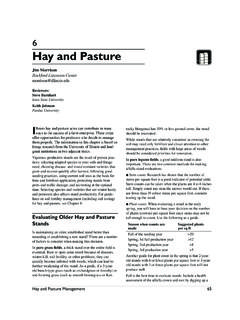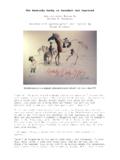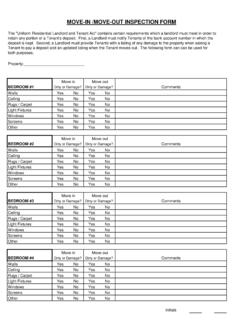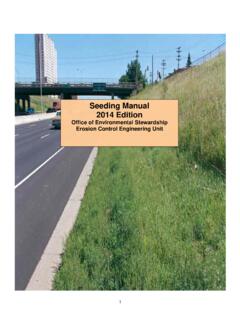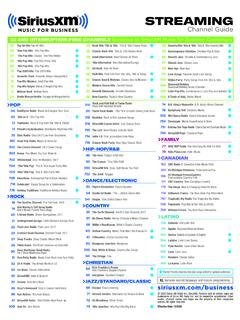Transcription of SCALES AND CHORDS FOR THE UPRIGHT BASS - Desert …
1 SCALES AND CHORDS FOR THE UPRIGHT BASSThe following keys should be learned in the order presented. All diagrams show theneck "standing up". (Strings are vertical while imaginary frets are shown horizontally.)The suggested fingering for the scale is to the left of the diagram. Practice the scaleuntil you can play it continuously and diagrams to the right are the CHORDS of the key derived from the scale. Thetechnical name for this group of CHORDS is the diatonic progression . There are threemajor CHORDS (1, 4, and 5) and three minor CHORDS (2m, 3m, and 6m). The suggestedfingering for each chord is to the left of the diagrams. The spelling (root-third-fifth) ofeach chord is below the diagram.
2 I recommend you learn the major CHORDS first. Thiswill allow you to play hundreds of songs right OF CKEY OF CKEY OF CKEY OF CThe key of C has no sharps and no flats. You will be unable to play a complete C scaleunless you change position with the fourth finger on string 1. (This is not necessary,unless it drives you crazy by not completing the scale.) Practice ascending from C toB, then back down. Repeat non-stop until it becomes fluent. Then practice the lowerpartial scale, descending from C to E, then back up. (Observe that the first finger playsthe F-note on the fourth string.) Repeat non-stop until it becomes course will deal with alternating 1(root)-5(fifth) bass parts.
3 However, in the longSCALES AND CHORDS FOR THE UPRIGHT BASS1 of 177/12/2011 7:58 AMrun it is a good idea to learn the complete chord arpeggio (all 1-3-5's) for variety. Learnthe major CHORDS first, then the minor number of possible 1-5 bass parts depends upon how many roots and fifths areavailable in each chord. The C and Dm CHORDS each have one root and two fifthsavailable allowing you to play two possible 1-5 bass parts. The F and G CHORDS eachhave two roots and one fifth available. This also will allow you to play two possible 1-5bass parts. The Em and Am CHORDS have two roots and two fifths available allowingyou to play three possible bass parts.
4 The following is a summary in the key of MEASURESCOUNTING MEASURESCOUNTING MEASURESCOUNTING MEASURESMost songs have four beats to a measure and most songs are made up offour-measure pieces. Practice counting four-measure pieces as follows (recite out louduntil fluent):When the counting is to the point of a "no-brainer" then play a root-fifth C-chord. Whilecontinuing to count play the root on the first beat and the fifth on the third beat. Thismethod of counting and playing a single chord must become a "no-brainer" before youadvance to the next bass player is the heart of the band. A steady bass player can keep other playersin line so practice with a metronome to develop steady timing.
5 (Tapping your foot onbeats one and three is also a good idea.)Here's the next phase!Progression 1 Progression 1 Progression 1 Progression 1: Practice the following 16-measure progression continuously whilecounting and changing CHORDS every four measures. (Always play a root on the firstSCALES AND CHORDS FOR THE UPRIGHT BASS2 of 177/12/2011 7:58 AMbeat and a fifth on the third beat.) Memorize and work out 2 Progression 2 Progression 2 Progression 2: Practice the following 8-measure progression while counting andchanging CHORDS every two measures. Memorize and work out 3 Progression 3 Progression 3 Progression 3: Practice the following 4-measure progression while counting andchanging CHORDS every measure.
6 Memorize and work out SONGSTWO-CHORD SONGSTWO-CHORD SONGSTWO-CHORD SONGSThe following simple songs can be played using just the 1- and 5- CHORDS . Play a rooton the first beat of the measure and a fifth on the third beat. Memorize eachprogression and use 8-measure progression is good for all of the following songs: MARY HAD ALITTLE LAMB, LONDON BRIDGE, BUFFALO GALS, GO TELL AUNT RHODY, LONGLONG TO MY LOU and HE'S GOT THE WHOLE WORLD uses this chord AND CHORDS FOR THE UPRIGHT BASS3 of 177/12/2011 7:58 AMThe following progression is good for ACHY BREAKY HEART, TOM DOOLEY, POLLYWOLLY DOODLE, and TAKE ME BACK TO TULSA. (This progression is called a"reversal", the second half is the opposite of the first.)
7 The following songs are following 4-measure progression is SHORTNIN' BREAD and FARMER IN THEDELL. Observe that measure 4 is split in half--two beats on the 5-chord, two beats onthe 1-chord. When this happens play the root of each chord. (From now on smallletters will indicate the bass line only during measures where there may be confusion)A song with several "split-measures" is SHOO FLY. THREE-CHORD SONGSTHREE-CHORD SONGSTHREE-CHORD SONGSTHREE-CHORD SONGSH undreds of songs can be played using the 1-, 4- and 5- CHORDS . Examples are: SCALES AND CHORDS FOR THE UPRIGHT BASS4 of 177/12/2011 7:58 AMThe following are variations of the 12-bar (12-measure) blues, a common progressionfor many early rock and roll songs.
8 (The last 5-chord in progression 1 is optional.)Popular 12-bar blues songs are BLUES STAY AWAY (progression 1), HOUND DOG(2), JOHNNY B. GOODE (1), KANSAS CITY (3), MIND YOUR OWN BUSINESS (2),ROCK AROUND THE CLOCK (1), ROLL OVER BEETHOVEN (2 & 3) COUNTING 3-BEAT MEASURESCOUNTING 3-BEAT MEASURESCOUNTING 3-BEAT MEASURESCOUNTING 3-BEAT MEASURESA song with three beats per measure is called a waltz . A waltz has a distinctboom-chuck-chuck rhythm with a heavy accent on the first beat. Practice countingfour-measure pieces as follows (recite it out loud):After the counting becomes effortless play a C-chord, alternating between the root andfifth on the first beat of each measure.
9 This method of counting and playing a singlechord must become a no-brainer before you advance to the next here's the next phase ..Progression 1 Progression 1 Progression 1 Progression 1: Practice this 16-measure progression continuously while counting andchanging CHORDS every four AND CHORDS FOR THE UPRIGHT BASS5 of 177/12/2011 7:58 AMProgression 2 Progression 2 Progression 2 Progression 2: Practice this 8-measure progression while counting and changingchords every two 3 Progression 3 Progression 3 Progression 3: When the chord changes after one measure play only the this 4-measure progression while counting and changing CHORDS are some familiar songs in 3/4 seven of HAPPY BIRTHDAY contains two CHORDS .
10 Sustain the 1-chord fortwo beats (the "slash" indicates another beat of 1) and play the 5-chord on the thirdbeat. DIATONIC SONGSDIATONIC SONGSDIATONIC SONGSDIATONIC SONGSSCALES AND CHORDS FOR THE UPRIGHT BASS6 of 177/12/2011 7:58 AMA song written using only CHORDS from the standard chord formula derived from a majorscale (1, 2m, 3m, 4, 5, 6m, 7 or 57) is said to be diatonic . If a song uses only thethree major CHORDS in a key (1, 4, & 5) the changes are fairly easy to hear andanticipate. (At the very least you have a 50% chance of changing to the right chordfrom wherever you are!) Songs become more complicated when minor CHORDS (2m, 3m,& 6m) are introduced.

